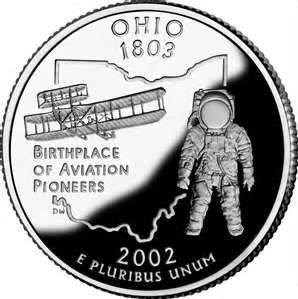Ohio General Assembly
A Brief History of Ohio's State Government
The story of Ohio's statehood dates back to the Ordinance of 1787 and the creation of the Northwest Territory--a large body of unsettled land that encompassed what is now Ohio, Indiana, Illinois, Michigan, Wisconsin, and part of Minnesota. The territory was ruled by a governor, a secretary, and three judges, who were all appointed by Congress. These five officials performed the executive, legislative and judicial functions of government. It wasn't until 1798--after the male adult population of the territory reached 5,000--that the settlers were given the right to elect a  house of representatives. The first meeting of the legislature convened in Cincinnati in 1799. The body elected Edward Tiffin as Speaker of the House and William Henry Harrison as the territory's representative to Congress. Though the territorial government was just getting on its feet in 1799, Ohio settlers were already clamoring for statehood. And just a few years later, in 1802, Congress passed an enabling bill that authorized the formation of a state government in Ohio. Ohio's first constitutional convention convened in Chillicothe in November of that same year. Ohio was admitted to the Union in 1803.
house of representatives. The first meeting of the legislature convened in Cincinnati in 1799. The body elected Edward Tiffin as Speaker of the House and William Henry Harrison as the territory's representative to Congress. Though the territorial government was just getting on its feet in 1799, Ohio settlers were already clamoring for statehood. And just a few years later, in 1802, Congress passed an enabling bill that authorized the formation of a state government in Ohio. Ohio's first constitutional convention convened in Chillicothe in November of that same year. Ohio was admitted to the Union in 1803.
 house of representatives. The first meeting of the legislature convened in Cincinnati in 1799. The body elected Edward Tiffin as Speaker of the House and William Henry Harrison as the territory's representative to Congress. Though the territorial government was just getting on its feet in 1799, Ohio settlers were already clamoring for statehood. And just a few years later, in 1802, Congress passed an enabling bill that authorized the formation of a state government in Ohio. Ohio's first constitutional convention convened in Chillicothe in November of that same year. Ohio was admitted to the Union in 1803.
house of representatives. The first meeting of the legislature convened in Cincinnati in 1799. The body elected Edward Tiffin as Speaker of the House and William Henry Harrison as the territory's representative to Congress. Though the territorial government was just getting on its feet in 1799, Ohio settlers were already clamoring for statehood. And just a few years later, in 1802, Congress passed an enabling bill that authorized the formation of a state government in Ohio. Ohio's first constitutional convention convened in Chillicothe in November of that same year. Ohio was admitted to the Union in 1803.Chillicothe served as the temporary capital for the new state until 1810 when the legislature moved the capital to Zanesville. The capital was shuttled back to Chillicothe in 1812, while the legislature searched for a more centralized location. The legislature finally decided to build a new capital on "the high banks of the Scioto River." Columbus became Ohio's permanent capital in 1816.
